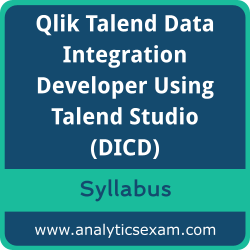 Welcome to your one-stop solution for all the information you need to excel in the Qlik Talend Data Integration Developer Using Talend Studio (DICD) Certification exam. This page provides an in-depth overview of the Qlik DICD Exam Summary, Syllabus Topics, and Sample Questions, designed to lay the foundation for your exam preparation. We aim to help you achieve your Qlik Talend Data Integration Certified Developer Using Talend Studio certification goals seamlessly. Our detailed syllabus outlines each topic covered in the exam, ensuring you focus on the areas that matter most. With our sample questions and practice exams, you can gauge your readiness and boost your confidence to take on the Qlik Talend Data Integration Developer Using Talend Studio exam.
Welcome to your one-stop solution for all the information you need to excel in the Qlik Talend Data Integration Developer Using Talend Studio (DICD) Certification exam. This page provides an in-depth overview of the Qlik DICD Exam Summary, Syllabus Topics, and Sample Questions, designed to lay the foundation for your exam preparation. We aim to help you achieve your Qlik Talend Data Integration Certified Developer Using Talend Studio certification goals seamlessly. Our detailed syllabus outlines each topic covered in the exam, ensuring you focus on the areas that matter most. With our sample questions and practice exams, you can gauge your readiness and boost your confidence to take on the Qlik Talend Data Integration Developer Using Talend Studio exam.
Why Qlik Talend Data Integration Developer Using Talend Studio Certification Matters
The Qlik DICD exam is globally recognized for validating your knowledge and skills. With the Qlik Talend Data Integration Certified Developer Using Talend Studio credential, you stand out in a competitive job market and demonstrate your expertise to make significant contributions within your organization. The Qlik Talend Data Integration Developer Using Talend Studio Certification exam will test your proficiency in the various syllabus topics.
Qlik DICD Exam Summary:
| Exam Name | Qlik Talend Data Integration Developer Using Talend Studio |
| Exam Code | DICD |
| Exam Duration | 90 minutes |
| Exam Questions | 55 |
| Passing Score | 70% |
| Exam Price | $250 (USD) |
| Books / Training |
Talend Data Fabric Getting Started Guide Talend Studio User Guide Talend Software Development Life Cycle Best Practices Guide Talend Components Data Integration Job Examples Logs and errors (Integration) Orchestration (Integration) |
| Exam Registration | Qlik |
| Sample Questions | Qlik Talend Data Integration Developer Using Talend Studio Certification Sample Question |
| Practice Exam | Qlik Talend Data Integration Developer Using Talend Studio Certification Practice Exam |
Qlik DICD Exam Syllabus Topics:
| Objective | Details |
|---|---|
| Getting started with data integration |
- Define Talend Data Integration - Describe the Talend Studio GUI - Create a simple Job |
| Working with files |
- Configure basic component properties - Create and configure a schema - Use the tMap component and configure a simple mapping - Use pre-defined Talend Java functions |
| Joining and filtering data |
- Define and configure Talend metadata - Join two sources of data using the tMap component - Define the tMap Join settings and its reject capture mechanism - Create a filter condition in tMap - Configure a filter reject output along with multiple filtered outputs |
| Using context variables |
- Define a standard context variable use case - Use context variables in a Job - Run Jobs in multiple contexts |
| Error handling |
- Use triggers to create a sequence of subJobs - Use logging components in a Job design - Create 'if' triggers based on component variables |
| Working with databases |
- Define a database metadata - Set actions on tables and data - Customize SQL queries in database components - Use metadata, generic schemas, and context variables in database components |
| Orchestrating Jobs |
- Explain a typical master Job use case - Describe the order of priority to pass parameters in context variables - Send dynamic parameters to a child Job by overriding context variables - Explain Joblets and compare then to other orchestration primitives - Refactor and create a Joblet from an existing Job - Create a Joblet from the ground up - Incorporate a Joblet into a Job - Explain different parallelization options available in Studio - Profile the execution of a Job with and without parallelism applied |
| Deploying Jobs |
- Build a Job and understand its options - Run a standalone Job - Handle context variables in standalone Jobs - Configure remote hosts in Studio - Launch a Job on a remote host |
| Project management |
- Explain key differences between a local and remote connection - Configure a remote connection in Talend Studio - Explain the key concepts of revision control (Git) - Perform operations on revision control - Define a reference project and use items from a reference project |
| Debugging | - Debug a Job using Traces Debug |
The Qlik has created this credential to assess your knowledge and understanding in the specified areas through the DICD certification exam. The Qlik Talend Data Integration Certified Developer Using Talend Studio exam holds significant value in the market due to the brand reputation of Qlik. We highly recommend thorough study and extensive practice to ensure you pass the Qlik Talend Data Integration Developer Using Talend Studio exam with confidence.
